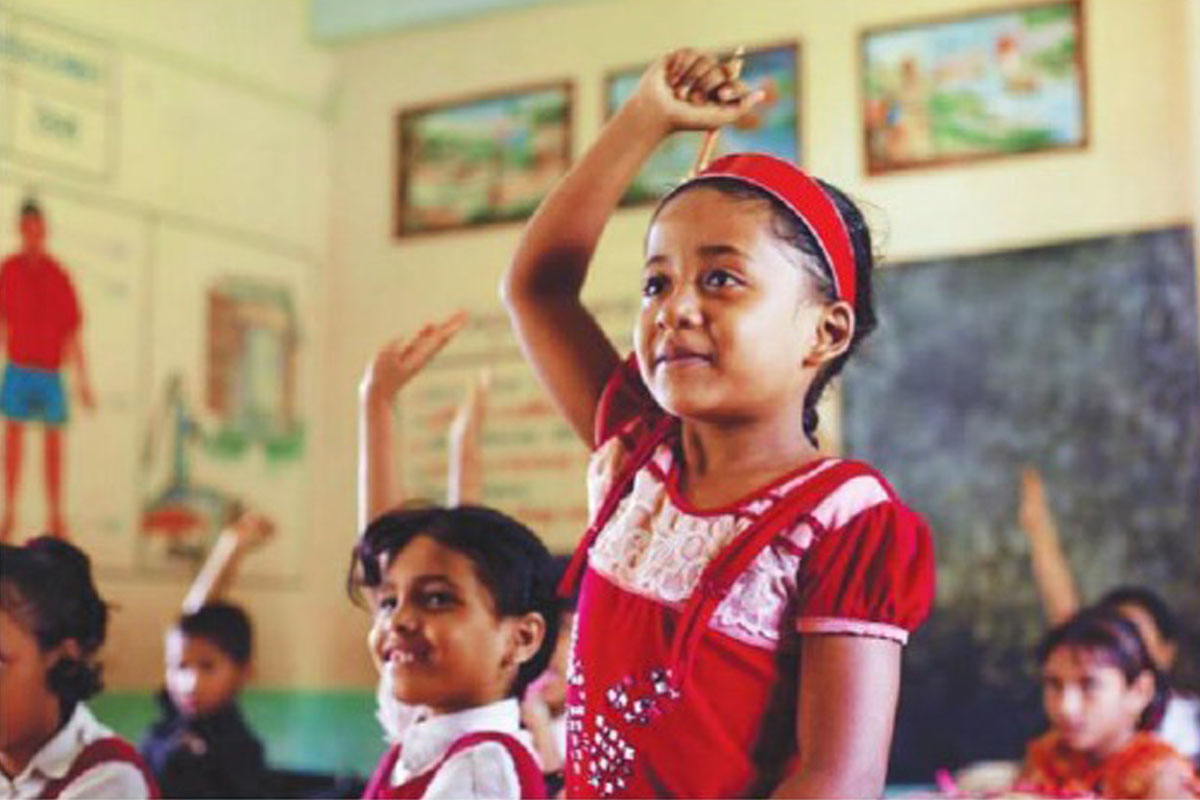Bangladesh, one of the most populous countries in the world, could achieve the feat of almost reaching the Millennium Development Goal (MDG) of primary education with a net enrolment ratio of 97.94 per cent in 2015, up from 60.5 per cent in 1991.
The enrolment ratio for girls was 98.8 per cent and for boys 96.6 per cent. Earlier it earned laurels from the World Bank for ‘improving access to education, ….and achieving gender equity in primary and secondary education’ in its 2013 report titled, “Seeding Fertile Ground: Education That Works for Bangladesh”.
Indeed, this is a commendable accomplishment for a relatively young nation which passed through a rough phase during the initial two decades after independence. The country suffered from a high national poverty rate of 71.3 per cent and an abysmally low adult literacy rate of 29.23 per cent, 17.9 per cent for females and 39.73 per cent for males in 1980.
The 1990s, in the wake of the global education-forall campaign, ushered a turnaround in Bangladesh like in many other countries. Bangladesh nationalised primary schools in two phases, one as early as in 1973 and the next in 2013, and now, has resolved to bring its more than 80,000 primary schools under a common administration through nationalisation.
The Primary Education (Compulsory) Act, 1990, unleashed a slew of pro-poor measures like elimination of school fees, free distribution of textbooks, etc. under a series of primary education development programmes (PEDP) launched since 1998. The girls’ enrolment in primary schools reached over four million by 2000, from about 0.6 million in 1980, while secondary enrolments more than doubled to about 8.5 million, in which girls constituted about 55 per cent.
Bangladesh thus, could build up one of the largest primary education systems in the world, universal in scope, and was on the threshold of eliminating the gender gap in primary education in the early nineties. The country adopted a twopronged strategy to broad base its primary education and made optimum utilisation of non-state providers, and at the same time followed a centralised education policy for overall control.
It has one of the largest concentrations of NGO activities in the world; more than 2,500 of them had been operating in different sectors, including education, in 2017. In a report in 2005, UNDP attributed their strong presence as the fall out of ‘dysfunctional governance and institutionalised political violence during early decades of liberation’. Bangladesh capitalised on their innovative school designs for extending outreach to the geographically remote areas and ethnically and socially marginal groups.
The foreign aid made entry only at a later stage for further enlarging the state’s footprint in the education sector. Jayanta Roy Chowdhury, a senior journalist, specialising on Indo-Bangladesh relations, commenting on the country’s stupendous progress in primary education, said that ‘it is the outcome of pragmatic and pro-active governmental actions, … adoption of the Sector Wide Approach (SWAp) in 1998, to avoid duplication of work and financial waste… and consideration of primary education as the bedrock of the educational system…in which the DG, Primary Education, Bangladesh plays a far more important role than his counter-part in higher Education’.
Several demand-side interventions like the massive Food for Education (FFE) programme, 1993, doled out grain rations to disadvantaged and landless families to incentivise the enrolment process of boys and girls. A UNESCO report corroborated that “it did boost enrolment and attendance, more for girls, which was up by 44 per cent as against 28 per cent for the boys”.
The Primary Education Stipend Project (PES Project), 2001, another incentive-based scheme was, however, criticised for its low stipend amount and got replaced by a five-year long single cash-based stipend programme, the Primary Education Stipend Programme (PESP), in 2002, with four times more stipend amount, targeting the poorest 40 per cent of primary school students in rural areas.
Apart from enrolment, it was aimed at countering rural poverty, child labour and boosting women’s empowerment, as the programme ensured a bank-mediated cash transfer directly to the mothers in a family. In the secondary education sector, the Female Secondary-School Scholarship Programme (FSSSP), 1993 took off with similar provisions like monthly cash stipend, and a schoolfee waiver for those girls who remain unmarried till the age of eighteen, to bridge the gender gap.
Evaluating its impact, UNESCO commented that ‘it was not only successful in enhancing attendance but could also put off child marriage’. Building on its success, a second-generation stipend programme was launched, benefiting about 2.3 million students, of whom 55 per cent were girls. In secondary education, successive governments forged an intense private-public partnership, and in Bangladesh about 98 per cent of secondary schools and madrasahs are privately operated with public subsidies.
Such engagement also could raise enrolment for girls from 39 per cent in 1998 to 67 per cent in 2017. Khushi Kabir, Executive Director, Nijera Kari, a prominent NGO in Bangladesh, however, raised concern about drop-out rates and said that “unless the trend is reversed …all efforts would go in waste.” According to the Bangladesh Bureau of Educational Information and statistics, the overall drop-out rate was as high as 42 per cent and completion rates a mere 59 per cent in 2017.
The human capital index, 2017, also raised the issue of ‘poor quality of teaching’ which resulted in an average loss of 4.5 years of schooling in Bangladesh. To avert the trend of this ‘learning crisis’, a programme named transforming secondary education for results (TSER) for the 13 million students from grades 6-12, especially for girls and children from poor households, has now been put in place.
Rasheda K Chowdhury, Executive Director (CEO), campaign for popular education or CAMPE, and an educationist, stressed the need for ’a complete revisit of the existing system of focussing more on public exams rather than continuous class room based normative assessments, as mooted in the education policy 2010 for a qualitative change….as numbers always do not matter’.
The national education policy 2010, and a law drafted thereof in 2016, is awaiting approval. Many felt that the proposed law is deficient in not having any right-based approach in the line of India’s right to education, or RTE, 2009. Bangladesh Prime Minister Sheikh Hasina at a convocation ceremony in India in 2018, asserted that ‘education is the only solution to bring down poverty’.
After returning to power for the fourth time, her government raised allocation to the education sector by 17 per cent to about 2 per cent of the GDP, which, of course, still stands way below the global commitment of six per cent. Nevertheless, the World Bank 2019 report said that ‘though the share of public spending on education is lower in Bangladesh than the South Asian average, yet it is among the few countries to achieve gender parity in school enrolment….… also bring down poverty rate to below 9 per cent in 2018’.
An analysis of the World Inequality Database on Education (WIDE) for eight countries, including India, found Bangladesh ‘the best for having the largest proportion of poorest girls (7- 16 years) in accessing education’. Bangladesh, has, indeed, targeted primary education as a stepping stone in changing the destiny of millions of boys, and girls too.
(The writer is a retired Indian Information Service Officer, and a media educator)












